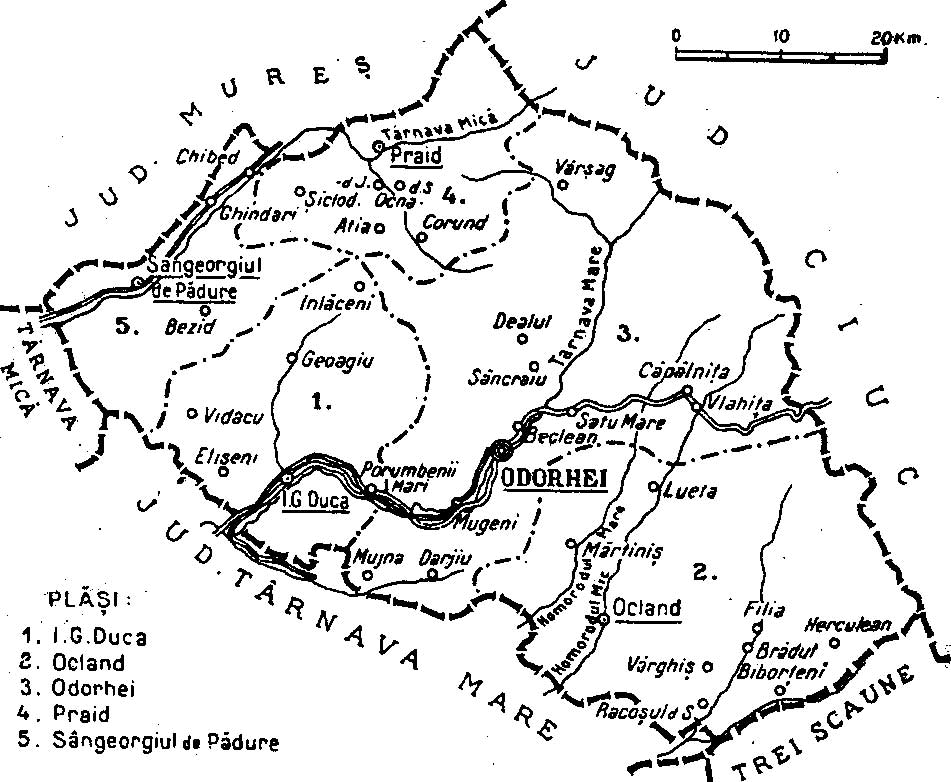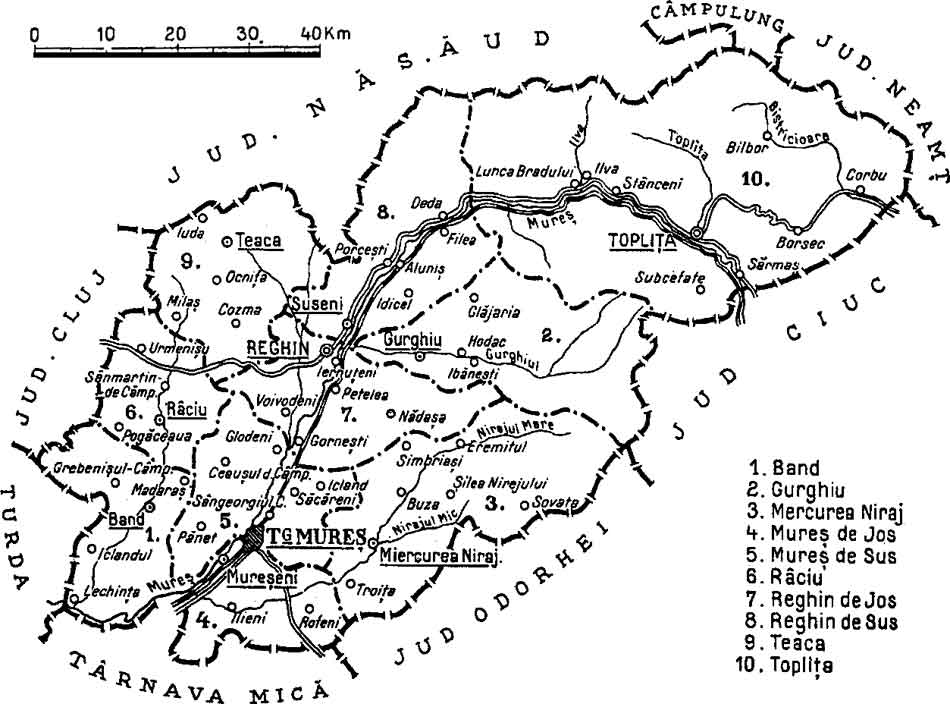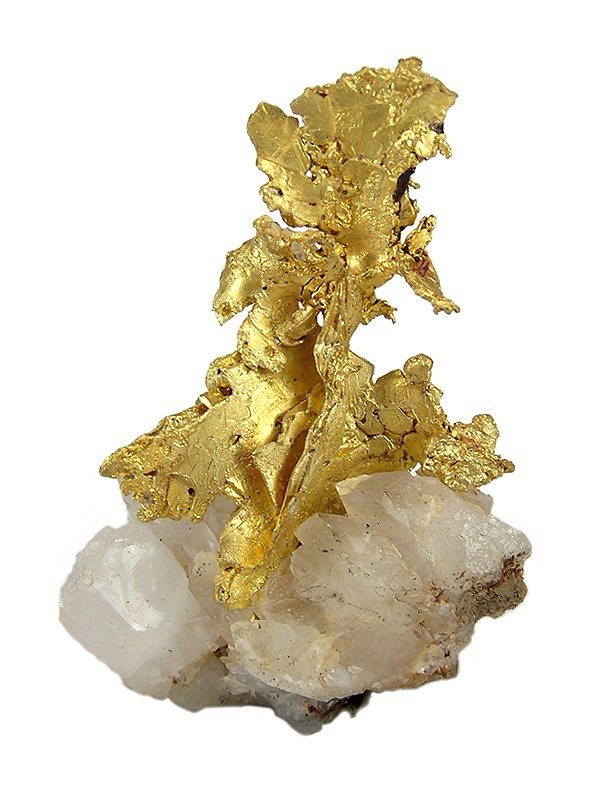|
»öinutul Mure»ô
Ținutul Mureș (draft version: Ținutul Alba Iulia) was one of the ten ''ținuturi'' ("lands") of Romania, founded in 1938 after King Carol II initiated an institutional reform by modifying the 1923 Constitution and the law of territorial administration. It comprised most of Transylvania, including parts of the Székely Land. Its capital was the city of Alba-Iulia. ''Ținutul Mureș'' ceased to exist following the territorial losses of Romania to Hungary and the king's abdication in 1940. Coat of arms The coat of arms is party per cross in 9 equal squares, representing the former 9 counties (ținuturi) of Greater Romania (71 in total) which it had included. Four of the squares, forming the arms of a Greek cross, are of or. The four squares forming the corners of the shield are of azure. The square in the heart of the shield is gules, and bares an or Romanian Crown (in recollection of the 1922 Alba-Iulia coronation of Ferdinand I and Marie of Edinburgh as King and Queen of ... [...More Info...] [...Related Items...] OR: [Wikipedia] [Google] [Baidu] |
Countries Of The World
The following is a list providing an overview of sovereign states around the world with information on their status and recognition of their sovereignty. The 205 listed states can be divided into three categories based on membership within the United Nations System: 193 member states of the United Nations, UN member states, two United Nations General Assembly observers#Current non-member observers, UN General Assembly non-member observer states, and ten other states. The ''sovereignty dispute'' column indicates states having undisputed sovereignty (188 states, of which there are 187 UN member states and one UN General Assembly non-member observer state), states having disputed sovereignty (15 states, of which there are six UN member states, one UN General Assembly non-member observer state, and eight de facto states), and states having a political status of the Cook Islands and Niue, special political status (two states, both in associated state, free association with New ... [...More Info...] [...Related Items...] OR: [Wikipedia] [Google] [Baidu] |
Or (heraldry)
In heraldry, or (/…îÀê Å/; French for "gold") is the tincture of gold and, together with argent (silver), belongs to the class of light tinctures called "metals". In engravings and line drawings, it is hatched using a field of evenly spaced dots. It is very frequently depicted as yellow, though gold leaf was used in many illuminated manuscripts and more extravagant rolls of arms. The word "gold" is occasionally used in place of "or" in blazon, sometimes to prevent repetition of the word "or" in a blazon, or because this substitution was in fashion when the blazon was first written down, or when it is preferred by the officer of arms. The use of "gold" for "or" (and "silver" for "argent") was a short-lived fashion amongst certain heraldic writers in the mid-20th century who attempted to "demystify" and popularise the subject of heraldry. "Or" is sometimes spelled with a capital letter (e.g. "Gules, a fess Or") so as not to confuse it with the conjunction "or". However, this i ... [...More Info...] [...Related Items...] OR: [Wikipedia] [Google] [Baidu] |
Târnava Mică County
The Târnava (full name in ; ; ; ) is a river in Romania. It is formed by the confluence of the Târnava Mare and Târnava Mică in the town of Blaj. The Târnava flows into the Mureș after 23 km near the town of Teiuș. The two source rivers of the Târnava are the Târnava Mare and Târnava Mică, and its tributaries include the Tur, Izvorul Iezerului, Secaș, and the Dunărița. Its drainage basin covers an area of .Analysis of the Tisza River Basin 2007 IPCDR Etymology The name Târnava is of |
Sibiu County
Sibiu County () is a county () of Romania, in the historical region of Transylvania. Its county seat () is the namesake town of Sibiu (). Name In Hungarian, it is known as ''Szeben megye'', and in German as ''Kreis Hermannstadt''. Under the Kingdom of Hungary, a county with an identical name (Szeben County, ) was created in 1876. Demographics At the 2021 census, Sibiu county had a population of 388.326 residents and a population density of 71.48/sq.km(27,59sq.mi) At the 2011 Romanian census, 2011 census, the county has the following population indices: * Romanians – 91.25% (or 340,836) * Romani people in Romania, Romani – 4.76% (or 17,901) * Hungarians in Romania, Hungarians – 2.89% (or 10,893) * Germans of Romania, Germans (Transylvanian Saxons) – 1.09% (or 4,117) * Minorities of Romania, Other – 0.1% (or 640) At the 2021 Romanian census, 2021 census, the county has the following population indices: * Romanians – 93.36% (or 313,118) * Romani people in ... [...More Info...] [...Related Items...] OR: [Wikipedia] [Google] [Baidu] |
Odorhei County
Odorhei County was a county (Romanian: ''județ'') in the Kingdom of Romania. The county seat was Odorheiu Secuiesc. Geography Odorhei County covered 2,977 km2 and was located in central part of Greater Romania, in eastern part of the historical region of Transylvania. It was bordered by Târnava-Mică County and Târnava-Mare County to the west and southwest, Mureș County to the north, Ciuc County to the east, and Brașov County and Trei-Scaune County to the south. Odorhei county was abolished in the administrative reforms of September 6, 1950. Currently, the territory that comprised the greater part of Odorhei County is now part of Harghita County, with some territory now belonging to the present-day counties of Covasna and Mureș. History Prior to World War I, the territory of the county belonged to Austria-Hungary and was identical with the Udvarhely County of the Kingdom of Hungary. The territory of Odorhei County was transferred to Romania from Hungary as successor state ... [...More Info...] [...Related Items...] OR: [Wikipedia] [Google] [Baidu] |
Mure»ô County
Mureș County (, , ) is a county (''județ'') of Romania, in the Historical regions of Romania, historical region of Transylvania, with the administrative centre in Târgu Mureș. The county was established in 1968, after the administrative reorganization that re-introduced the historical ''județ'' (Counties of Romania, county) system, still used today. This reform eliminated the previous Magyar Autonomous Region, Mureș-Magyar Autonomous Region, which had been created in 1952 within the People's Republic of Romania. Mureș County has a vibrant multicultural fabric that includes Székely Land, Hungarian-speaking Székelys and Transylvanian Saxons, with a rich heritage of Villages with fortified churches in Transylvania, fortified churches and towns. Name In Hungarian language, Hungarian, it is known as ''Maros megye'' (), and in German language, German as ''Kreis Mieresch''. Under Kingdom of Hungary, a county with a similar name (Maros-Torda County, ) was created in 1876. There ... [...More Info...] [...Related Items...] OR: [Wikipedia] [Google] [Baidu] |
Făgăraș County
Făgăraș County is one of the historic counties of Transylvania, Romania. The county seat was Făgăraș. Geography Făgăraș County covered and was located in the central part of Greater Romania, in the southeastern part of Transylvania, along the Olt River. Currently, the territory that comprised Făgăraș County is now mostly included in Brașov County, while its western part belongs now to Sibiu County. History After World War I, as a result of the Treaty of Trianon, Fogaras County along with most of Transylvania was transferred from the Kingdom of Hungary to Romania, Făgăraş County was created with an identical territory. Based on the 1923 Romanian Constitution and the Law of Administrative Unification of 1925, the name of the county remained as it was, but the territory was reorganized. Its capital remained Făgăraș. The new county divided into three administrative districts (), it neighbored Târnava-Mare County to the north, Brașov County to the east, Muscel an ... [...More Info...] [...Related Items...] OR: [Wikipedia] [Google] [Baidu] |
Ciuc County
Ciuc County is a historical county ( Romanian: ''județ'') in the Kingdom of Romania. Its capital was Miercurea Ciuc. Its name was derived from the former county of the Kingdom of Hungary, Csík. History Prior to World War I, the territory of the county belonged to Austria-Hungary and was identical with the Csík County of the Kingdom of Hungary. The territory of Ciuc County was transferred to Romania from Hungary as successor state to Austria-Hungary in 1920 under the Treaty of Trianon. After the administrative unification law in 1925, the name of the county remained as it was, but the territory was reorganized. In 1938, King Carol II promulgated a new Constitution, and subsequently he had the administrative division of the Romanian territory changed. 10 ''ținuturi'' (approximate translation: "lands") were created (by merging the counties) to be ruled by ''rezidenți regali'' (approximate translation: "Royal Residents") - appointed directly by the King - instead of the prefe ... [...More Info...] [...Related Items...] OR: [Wikipedia] [Google] [Baidu] |
Alba County
Alba County () is a county (județ) of Romania located in the historic region of Transylvania. Its capital is Alba Iulia, a city with a population of 63,536. Name "Alba", meaning "white" in Latin and Romanian, is derived from the name of the city of Alba Iulia. In Hungarian language, Hungarian, the county is known as ''Fehér megye'' (fehér also meaning white), and in German language, German as ''Kreis Karlsburg''. Geography This county has a total area of , with mountains occupying about 59% of its surface. The Apuseni Mountains are in the northwest; the northeastern side of the Parâng Mountains group – the Șureanu Mountains, Șureanu and Cindrel Mountains, Cindrel mountains – are in the south. In the east there is the Transylvanian Plateau with deep but wide valleys. The three main elements are separated by the Mureș (river), Mureș River valley. The main rivers are the Mureș (river), Mureș River and its tributaries, the Târnava, the Sebeș (river), Sebeș, ... [...More Info...] [...Related Items...] OR: [Wikipedia] [Google] [Baidu] |
Marie Of Edinburgh
Marie (born Princess Marie Alexandra Victoria of Edinburgh; 29 October 1875 – 18 July 1938) was the last queen of Romania from 10 October 1914 to 20 July 1927 as the wife of King Ferdinand I. Marie was born into the British royal family. Her parents were Prince Alfred, Duke of Edinburgh (later Duke of Saxe-Coburg and Gotha), and Grand Duchess Maria Alexandrovna of Russia. Marie's early years were spent in Kent, Malta and Coburg. After refusing a proposal from her cousin, the future King George V, she was chosen as the future wife of Ferdinand, then crown prince of Romania, in 1892. Marie was crown princess between 1893 and 1914, and became immediately popular with the Romanian people. After the outbreak of World War I, Marie urged Ferdinand to ally himself with the Triple Entente and declare war on Germany, which he eventually did in 1916. During the early stages of fighting, the national capital Bucharest was occupied by the Central Powers. Marie, Ferdinand and th ... [...More Info...] [...Related Items...] OR: [Wikipedia] [Google] [Baidu] |
Ferdinand I Of Romania
Ferdinand I (Ferdinand Viktor Albert Meinrad; 24 August 1865 – 20 July 1927), nicknamed ''Întregitorul'' ("the Unifier"), was King of Romania from 10 October 1914 until his death in 1927. Ferdinand was the second son of Leopold, Prince of Hohenzollern, and Infanta Antónia of Portugal, (daughter of Queen Maria II of Portugal and of Ferdinand II of Portugal, Prince Ferdinand of Saxe-Coburg and Gotha-Kohary). His Hohenzollern-Sigmaringen, family was part of the Catholic branch of the Prussian royal family Hohenzollern. In 1886, Ferdinand became heir presumptive to the Romanian throne, following the renunciation of his father (in 1880) and William, Prince of Hohenzollern, older brother. From the moment he settled in Romania, he continued his military career, gaining a series of honorary commands and being promoted to the rank of corps general. He married in 1893 Marie of Romania, Princess Marie of Edinburgh, granddaughter of both Queen Victoria and Alexander II of Russia, Emperor ... [...More Info...] [...Related Items...] OR: [Wikipedia] [Google] [Baidu] |







